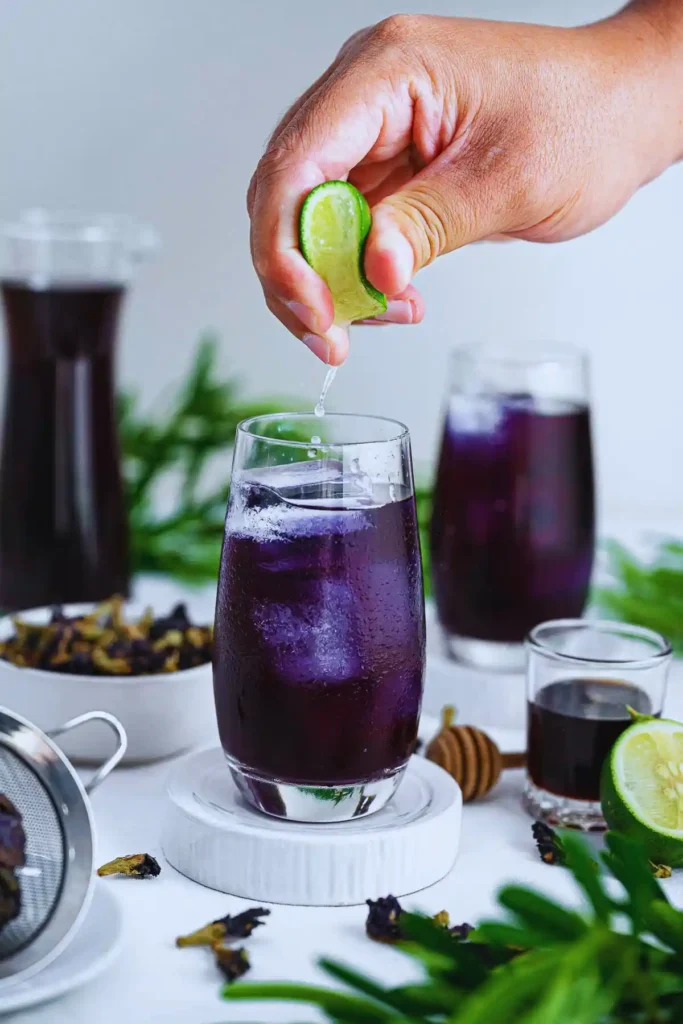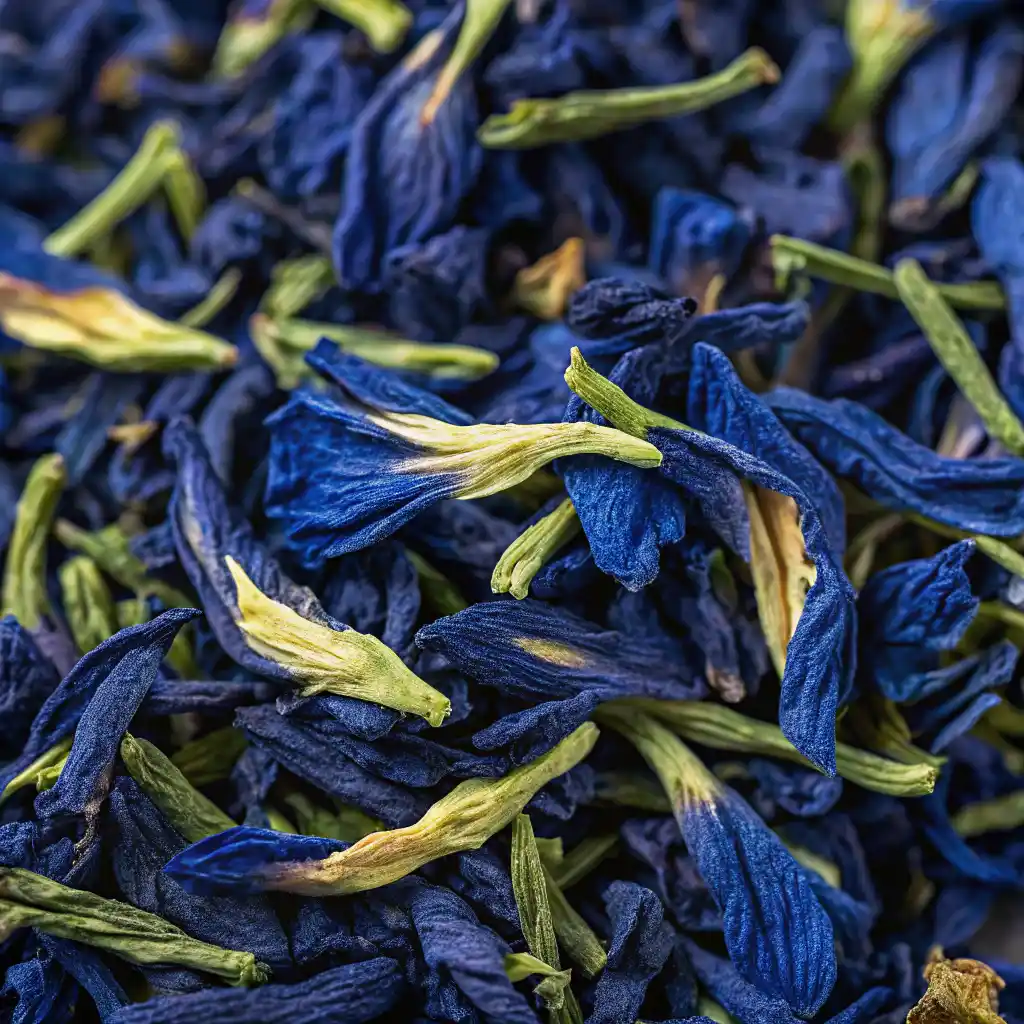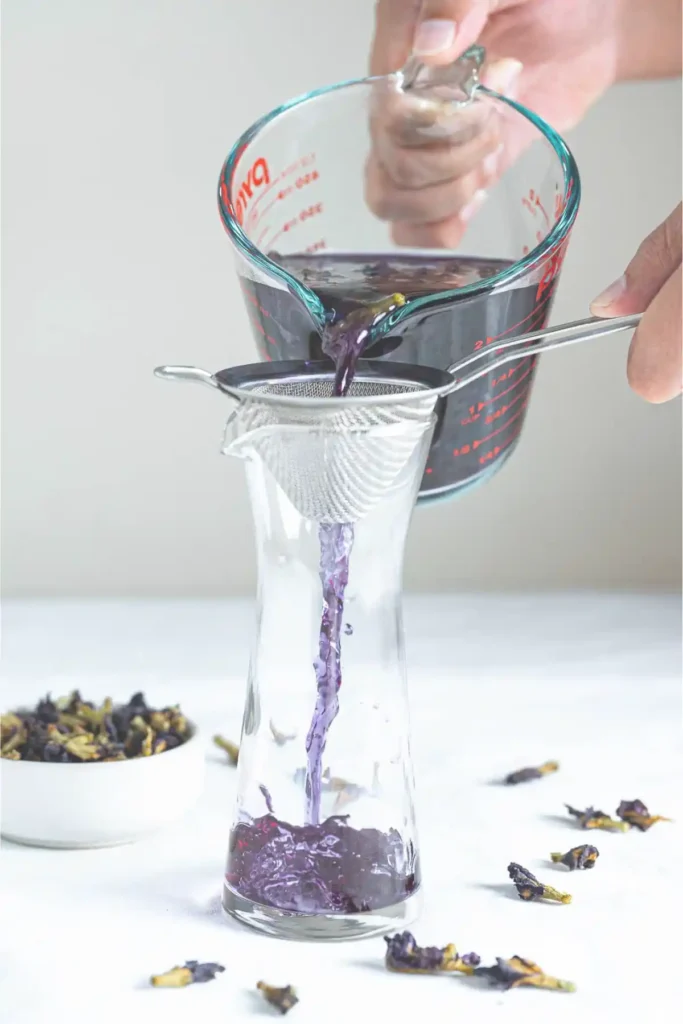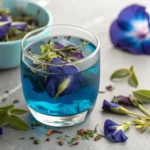Butterfly pea tea wasn’t just another trendy herbal brew for Elle it was a memory, a legacy, and a promise fulfilled. It all started the summer her grandmother fell ill, losing her appetite and growing more fatigued by the day. Doctors recommended rest and a nutrient-rich diet, but Elle knew her grandmother needed more than pills and soup she needed comfort.
While flipping through an old family recipe book passed down from her Thai great-grandmother, Elle stumbled upon a note scribbled in delicate cursive: “Blue tea for tired days – sweetened with lemon, best served with love.” Curious, she researched more and discovered the magic of butterfly pea teas a vibrant blue infusion made from Clitoria ternatea flowers, rich in antioxidants and often used to improve mood, reduce inflammation, and even support memory. It wasn’t just beautiful to look at it had healing power.
Determined, Elle tracked down organic dried butterfly pea flowers from a local herbalist, brewed a cup with fresh lemon slices, and served it warm to her grandmother. The color shifted from deep ocean blue to a bright violet swirl almost like a potion out of a fairy tale. Her grandmother smiled for the first time in weeks and whispered, “It tastes like a garden in spring.”
From that moment on, butterfly pea teas became their evening ritual. Elle began experimenting, pairing it with mint, ginger, or honey, sometimes chilling it with ice or mixing it into smoothies. The tea didn’t just help her grandmother feel better it brought them closer. Elle even noticed how it helped herself too her focus improved, her skin glowed, and every cup reminded her of purpose.
Today, Elle shares her recipes, brewing secrets, and all the incredible benefits she’s discovered with butterfly pea teas not just as a beverage, but as a bridge between generations, traditions, and healing. In this guide, you’ll uncover everything from its weight loss potential to the exact way Elle learned to brew it without bitterness just like her grandmother loved.
Don’t miss our expert guide on steeping tea without bitterness a technique Elle used to get butterfly pea tea just right.
Introduction to Butterfly Pea Tea
PrintButterfly Pea Tea: Benefits, Side Effects, Weight Loss, and How to Brew It Right
Butterfly pea tea or blue tea is an herbal drink that is very popular in Thailand. It’s lovely either hot or cold and you can add more flavor to it with a bit of honey and a squeeze of lime. The best part is you can make it under 10 minutes!
- Prep Time: 5 minutes
- Cook Time: 5 minutes
- Total Time: 10 minutes
- Yield: 2
- Category: tea
- Method: Beverages, Drinks
- Cuisine: Thai
Ingredients
Butterfly Pea Tea
- ¼ cup dried butterfly pea flowers
- 2 cups water
- 2 glasses ice
-
Optional
- sugar or simple syrup or honey to taste
- lime juice or lemon juice to taste
Instructions
-
Boil 2 cups of water in a kettle. Transfer the water to a medium or large Pyrex measuring cup and add the dried butterfly pea flowers to the water.
-
Stir the flowers in the water with a spoon and use the back of the spoon to press the flowers against the cup to extract their color.
-
Continue to press the flowers for a few minutes or the color of the tea is dark enough.
-
Strain the tea with a mesh strainer and discard the flowers. Add sugar or syrup or honey and/or lemon or lime juice, if using.
-
Fill two glasses with ice.
-
Pour the blue pea tea into the glasses.
Notes
- To make blue tea, you can use either fresh or dried butterfly pea flowers.
- If you want the color to be strong, let the flowers steep in hot water for a few minutes and use the back of a spoon to press the flowers against the cup to extract more color.
- If you’re making a large amount of the simple blue tea or the sweetened version, it will keep in the fridge for 2-3 days. If you want to have or serve it with lemon or lime juice, just add that when ready to drink.
Nutrition
- Serving Size: 2 drinks
- Sodium: 24mg
What is Butterfly Pea Tea?
Butterfly pea tea is a vibrant herbal infusion made from the dried petals of the Clitoria ternatea plant. Known for its stunning blue hue that changes color when the pH shifts especially with lemon juice this caffeine-free tea has gained popularity not only for its visual appeal but also for its medicinal benefits. While often served iced in wellness cafes or hot in Ayurvedic rituals, it’s much more than a pretty drink. Butterfly pea tea is packed with antioxidants, making it a powerhouse for natural health enthusiasts and beauty lovers alike.
History and Cultural Significance of Clitoria Ternatea
The butterfly pea tea tradition traces its roots back to Southeast Asia, especially in countries like Thailand, Vietnam, and Malaysia. In traditional Thai medicine, the flower is used for stress relief, memory enhancement, and even as a natural dye. Known as dok anchan in Thai culture, it’s often consumed before meditation or offered to guests as a calming welcome drink. Ayurveda also praises Clitoria ternatea for balancing the body’s doshas and promoting mental clarity. Its rich cultural lineage makes butterfly pea tea not just a beverage, but a living tradition.
Health Benefits of Drinking Butterfly Pea Tea

What Does Drinking Butterfly Pea Tea Do for Your Body?
Drinking butterfly pea tea on a regular basis may improve your overall health in subtle yet powerful ways. It’s known for its anti-inflammatory, analgesic, and antipyretic properties. Many drink it to reduce oxidative stress, enhance skin elasticity, and even boost circulation. Rich in flavonoids and anthocyanins, butterfly pea tea can help protect your cells from free radicals, support digestion, and hydrate the body—making it an ideal drink for wellness routines.
Cognitive, Anti-Aging, and Immune System Benefits
One of the most celebrated benefits of butterfly pea tea is its impact on brain health. Thanks to compounds like cyclotides and anthocyanins, this tea may help improve memory, reduce symptoms of anxiety, and stimulate neurotransmitter function. It also contains peptides that promote collagen production, slowing the visible signs of aging. Additionally, butterfly pea tea has antimicrobial properties, supporting your immune system and helping your body fight infections naturally without the side effects of synthetic medications.
Weight Loss and Metabolism Effects
Does Butterfly Pea Tea Help You Lose Weight?
Many people turn to butterfly pea tea as a natural aid for weight loss. While it’s not a miracle cure, it plays a supportive role by boosting metabolism and improving digestion. The tea’s diuretic effect helps eliminate water retention and bloating, while the antioxidants encourage fat breakdown by reducing oxidative stress in fat cells. When consumed regularly as part of a balanced diet and exercise plan, butterfly pea tea may assist in achieving sustainable weight goals.
How to Make Butterfly Pea Tea for Weight Loss (Recipe & Timing)
To make butterfly pea tea for weight loss, steep 1 teaspoon of dried butterfly pea flowers in 8 oz of hot (not boiling) water for 5–7 minutes. Add lemon to enhance its fat-burning properties and squeeze in fresh ginger for digestive support. Drink it twice a day once in the morning on an empty stomach and once in the evening before dinner. Avoid adding sugar. You can chill it and enjoy it iced for a refreshing twist that supports your fitness goals.
Butterfly Pea Tea Taste and Appearance

What Does Butterfly Pea Tea Taste Like?
The taste of butterfly pea tea is surprisingly mellow. It has a light, earthy flavor with subtle vegetal notes, often compared to green tea but without the bitterness or caffeine. Some describe it as having a floral undertone, while others pick up hints of pea pods or chamomile. It’s a fantastic base for flavored drinks because it doesn’t overpower added ingredients like lemon, honey, or mint.
Why Does Butterfly Pea Tea Turn Purple? The Science of Anthocyanins
One of the most mesmerizing features of butterfly pea tea is its ability to change color. This transformation occurs due to the anthocyanins in the flower petals natural pigments that react to changes in pH. When you add lemon juice or other acidic ingredients, the tea shifts from vibrant blue to royal purple or pinkish-magenta. This visual magic is one reason butterfly pea tea has gone viral on social media, but it’s also a sign of powerful antioxidants at work.
Step-by-Step Instructions to Make Butterfly Pea Tea
Making butterfly pea tea at home is easy, colorful, and perfect for any season. Whether you’re enjoying it for health, beauty, or fun, this step-by-step guide will help you create the perfect brew every time.
Quick Tip for Deep Color Extraction
If you want the color to be especially vibrant, let the dried butterfly pea tea flowers steep in hot water for several minutes. Use the back of a spoon to press the flowers gently against the cup or teapot wall—this releases more of the rich blue pigment naturally found in the petals.
Step-by-Step Instructions To make Butterfly pea tea

Step 1: Boil Water
Boil 2 cups of water in a kettle. Once it reaches a rolling boil, transfer it to a heat-safe Pyrex measuring cup or a teapot.
Step 2: Add Butterfly Pea Flowers
Add 1–2 teaspoons of dried butterfly pea tea flowers into the hot water. These flowers should float at the top initially.
Step 3: Stir and Press
Stir the tea gently and then press the flowers against the side of the cup or teapot with the back of a spoon. This releases more of the tea’s natural indigo blue pigment, enhancing both color and antioxidant content.
Step 4: Steep and Strain
Continue pressing and steeping until the tea becomes a deep blue (about 5–7 minutes). Once the color is rich, strain the tea using a mesh strainer. Discard the flowers. This is when you can stir in sweeteners like sugar, syrup, or honey. If you’d like to enjoy its pH-sensitive magic, add lemon or lime juice now and watch the tea change from blue to purple.

Step 5: Prepare Glasses
Fill two glasses with fresh ice cubes. This tea is absolutely refreshing when served cold, especially during warm weather.
Step 6: Pour and Serve
Slowly pour the brewed butterfly pea teas into the glasses. If you’ve added lemon, you’ll notice the color shift from deep blue to violet as it cascades over the ice. Stir lightly and enjoy immediately.
Disadvantages and Side Effects of Butterfly Pea Teas
What Are the Disadvantages of Butterfly Pea Tea?
While butterfly pea teas is generally safe, there are a few drawbacks to be aware of. Overconsumption may lead to nausea or stomach upset, especially if consumed in concentrated doses. Some users have reported drowsiness or mild headaches. As with any herbal supplement, moderation is key, and it’s always best to consult a healthcare provider before making it a daily habit.
Possible Interactions and Who Should Avoid It
If you’re pregnant, breastfeeding, or taking blood-thinning medications, you should approach butterfly pea teas with caution. The tea may interact with anticoagulants or diuretics, altering their effectiveness. Additionally, individuals with low blood pressure should avoid excessive intake, as the tea has mild hypotensive properties. Always check with your doctor, especially if you’re on medication or have underlying health conditions.
Brewing the Perfect Cup
Is Butterfly Pea Tea Better Cold or Hot?
The beauty of butterfly pea tea lies in its versatility it’s delightful both hot and cold. When served hot, it offers a calming experience, ideal for evenings or quiet mornings. Cold, it becomes a vibrant refreshment perfect for summer, especially when enhanced with citrus or cucumber slices. The best choice depends on your mood and purpose: hot for relaxation, cold for revitalization.
How to Steep Butterfly Pea Tea Without Bitterness (Inspired by Green Tea Techniques)
To avoid bitterness in butterfly pea tea, steep it gently like green tea. Use filtered water heated to about 190°F, not boiling. Let the petals steep for 4–5 minutes only any longer can lead to an astringent taste. For flavor enhancement without adding sugar, try a splash of lemon juice or a sprig of mint. Discover great ideas like how to steep tea without bitterness to perfect your cup every time.
Complementary Pairings and Creative Recipes
What Pairs Well With Butterfly Pea Tea?
Butterfly pea teas pairs beautifully with a variety of flavors. Citrus fruits like lemon or lime not only change its color but also brighten its taste. Herbs like mint, basil, or lemongrass enhance its soothing properties. For a creamy treat, pair it with coconut milk or almond milk. Honey, ginger, or cinnamon also make excellent companions for both hot and iced versions.
Butterfly Pea Tea Latte, Lemonade, and Cocktails
Get creative with butterfly pea teas by turning it into trendy drinks. A butterfly pea latte combines the tea with steamed plant milk and a touch of maple syrup. For a summer favorite, try butterfly pea lemonade simply mix chilled tea with fresh lemon juice and sweetener. You can also craft color-changing cocktails by mixing it with tonic water, gin, or rum for a dramatic effect at parties.
Aesthetic and Oral Effects
Does Butterfly Pea Tea Stain Your Teeth?
One common concern is whether butterfly pea teas stains your teeth. Unlike black tea or coffee, this tea has minimal staining effects due to its lower tannin content. However, if consumed in high quantities daily, especially when mixed with acidic ingredients like lemon, slight staining may occur. To avoid it, rinse your mouth with water after drinking.
Teeth-Staining Properties vs Herbal Alternatives
Compared to herbal infusions like hibiscus or rooibos, butterfly pea teas is less aggressive on tooth enamel. It’s a safe alternative for people who enjoy colorful drinks but want to maintain white teeth. Drinking it through a straw and maintaining good oral hygiene further reduces any risk of discoloration.
Sustainable Harvesting and Where to Buy
How Butterfly Pea Flowers Are Harvested Sustainably
High-quality butterfly pea teas starts with ethical harvesting. In many Southeast Asian communities, the flowers are handpicked early in the morning and dried using solar or shade-drying techniques to preserve their color and nutrients. Many farms now follow sustainable practices no pesticides, organic soil use, and community-led harvesting to ensure ecological balance and fair trade.
Where to Buy Organic Butterfly Pea Tea (USA-Focused)
In the U.S., butterfly pea teas is widely available online and in wellness stores. Look for USDA-certified organic brands to ensure quality and safety. Reputable options include specialty tea shops, Etsy sellers, and herbal apothecaries. Always check labels for origin and purity. Avoid teas with additives or artificial colors real butterfly pea tea needs none of that.
FAQs for Butterfly Pea Tea
What does drinking butterfly pea tea do?
Drinking butterfly pea tea offers a range of health benefits. It’s rich in antioxidants, particularly anthocyanins, which help protect your body from oxidative stress and cellular damage. Regular consumption may support cognitive function, improve mood, reduce inflammation, and enhance skin health. Many people also use it for detoxification and hydration, making it a soothing and functional wellness drink.
What are the disadvantages of butterfly pea tea?
While butterfly pea tea is generally safe for most people, it may cause mild side effects in certain cases. Overconsumption can lead to nausea or an upset stomach. Those with low blood pressure or who are taking anticoagulants should consult a doctor before drinking it, as it may interfere with medications. Pregnant and breastfeeding women are also advised to use caution due to limited safety data.
Does butterfly pea flower tea help you lose weight?
Yes, butterfly pea tea can support weight loss as part of a healthy lifestyle. It has metabolism-boosting properties and helps reduce water retention. Because it’s caffeine-free and naturally low in calories, it’s an excellent alternative to sugary or calorie-dense beverages. When combined with lemon or ginger, butterfly pea tea can enhance digestion and aid in fat breakdown.
What does butterfly pea tea taste like?
Butterfly pea tea has a mild, earthy flavor with subtle floral and vegetal notes. It’s smooth and non-bitter, which makes it versatile for blending with herbs, fruits, and sweeteners. Unlike stronger teas, it doesn’t overpower the palate, making it ideal for mixing into lattes, lemonades, or even cocktails.
Does butterfly pea tea stain your teeth?
In most cases, butterfly pea tea does not stain your teeth. Its low tannin content means it’s much gentler on enamel compared to black tea or coffee. However, if consumed daily and especially when mixed with acidic ingredients like lemon, some minimal discoloration may occur over time. Rinsing your mouth with water after drinking can help prevent any staining.
How to make butterfly pea tea for weight loss?
To prepare butterfly pea tea for weight loss, steep 1 teaspoon of dried butterfly pea flowers in 8 oz of hot (not boiling) water for 5–7 minutes. Add fresh lemon juice to trigger the purple color change and boost detox effects. For added fat-burning, include a slice of fresh ginger. Drink this blend twice a day once in the morning and once in the evening for optimal results.
Is butterfly pea tea better cold or hot?
Butterfly pea tea is equally enjoyable hot or cold it depends on your preference. Hot butterfly pea tea is calming and great for winding down, while iced butterfly pea tea is refreshing and ideal for summer. Cold brews are also excellent for preserving nutrients and delivering a smooth, non-bitter flavor, especially when paired with citrus or mint.
Why does butterfly pea tea turn purple?
The vibrant blue color of butterfly pea tea turns purple when exposed to acidic ingredients like lemon juice. This color change is caused by anthocyanins natural pigments found in the butterfly pea flower that are sensitive to pH levels. The more acidic the environment, the more dramatic the color shift, often resulting in stunning purple or magenta hues.
What pairs well with butterfly pea tea?
Butterfly pea tea pairs wonderfully with lemon, lime, ginger, mint, and honey. For a creamy experience, mix it with almond or coconut milk. It’s also a favorite in cocktail recipes when combined with gin or tonic. For a refreshing twist, pair it with cucumber slices, basil, or fresh berries. Its subtle flavor makes it easy to blend into a variety of drinks and recipes.
Conclusion
Butterfly pea tea is more than just a colorful Instagrammable beverage it’s a botanical treasure rooted in culture, wellness, and natural beauty. Whether you drink it to boost focus, support your metabolism, or simply unwind with its soothing floral taste, this tea offers a rare blend of therapeutic benefits and visual appeal. From Elle’s grandmother’s cozy kitchen to your own daily rituals, it carries the essence of healing, memory, and joy.
Ready to explore even more ways to steep, flavor, and benefit from your tea?
Discover great ideas like how to steep tea without bitterness and pair your cup with smart hydration like our sea moss green juice recipes.
Check out watermelon limeade recipe for the perfect summer drink, or dive into our taro milk tea guide for a creamy twist..


